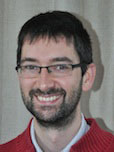Faculty Profile-Roberto Tron
By Rachel Riley
 Mechanical Engineering Professor Roberto Tron received a 300-pound, $30,000 delivery last week: Baxter, a 3-foot tall humanoid robot with two arms and an animated face.
Mechanical Engineering Professor Roberto Tron received a 300-pound, $30,000 delivery last week: Baxter, a 3-foot tall humanoid robot with two arms and an animated face.
Baxter is a practical addition at small and large companies across the U.S., where it can easily be programmed to perform repetitive tasks and assist in manufacturing.
But can Baxter be automated to see the answers to more complex problems? For example, could a researcher develop an algorithm that could tell Baxter how to solve a jigsaw puzzle by using camera sensors to take a picture of the pieces, analyzing the image, solving the puzzle internally, and using its vacuum cup gripper hands to arrange the pieces?
That’s where Tron comes in. He specializes in computer vision, a mathematical field that aims to enable computers to interpret and understand real-world images.
“I want to start working on using computer vision to control humanoid robots,” said Tron, who began teaching at Boston University’s Department of Mechanical Engineering in January.
For a robot like Baxter, computer vision could increase its capacity to not only accomplish impressive tasks like jigsaw puzzle solving, but also make it more useful for industrial purposes.
“Right now, there’s a change occurring in industrial robotics,” Tron said. “In the 80s,,there was a big development wave of robots in industry, where you had really large robots in a long assembly line. The new wave is small batch operations.”
While robots are often used in production to complete one step of the manufacturing process over and over again, researchers are now focusing on programming robots to accomplish multiple steps of assembling a product, Tron said.
Tron was not always interested in robotics. From a small town near Turin, Italy, he earned his bachelor’s and master’s degrees at Politecnico di Torino in telecommunications engineering.
“In telecommunication my favorite part was the encoding and compression of images and video analysis, and that got me into computer vision,” he said.
Two weeks after moving to America to earn his PhD in computer vision at John Hopkins, he met his wife, who was studying medicine there.
From 2013 to 2015, he completed his postdoctoral fellowship at University of Pennsylvania’s GRASP Lab, a renowned laboratory for robotics, automation, sensing, and perception.
During his time at GRASP, he worked on using computer vision to program drones to fly in a formation. Under the system he developed, a drone could theoretically be automated to fly in formation with many drones by only communicating with two or three other agents in the system.
While at Boston University, Tron aims to implement the algorithms he produced at GRASP on real drones. This technology could be useful for enabling groups of small drones to transport items to hard-to-reach places, he said.
Tron is excited by the opportunity to work with real robots at in the new BU Robotics Lab, a 3400sf facility that includes a flying arena, a build space and collaborative space for students and faculty, as well as the other perks offered by a large research institution.
“I like the academia environment versus industry because I get to influence the next generation of engineers,” he said. “I also like the fact that you actually get to choose what research problem you really care about and work on that. At the end of the day, it’s rewarding to see a real system performing the task you designed it to do.”